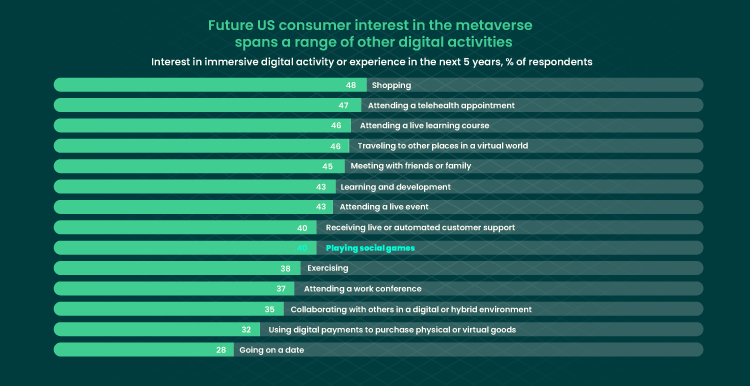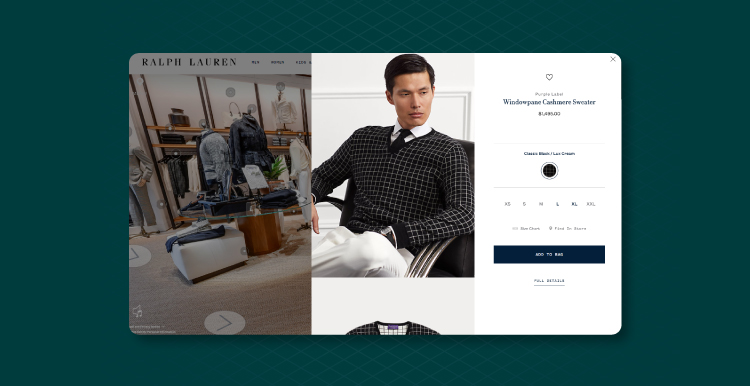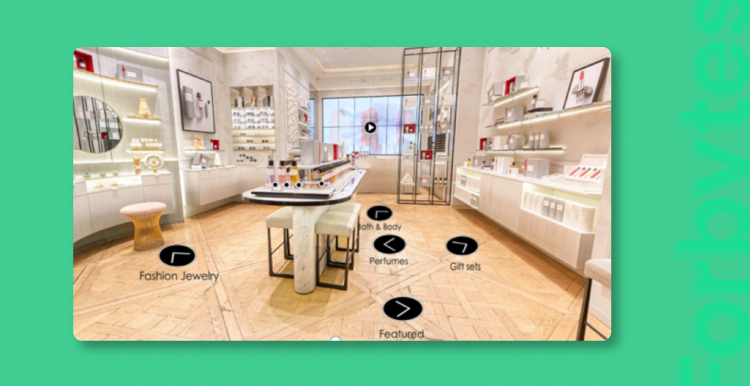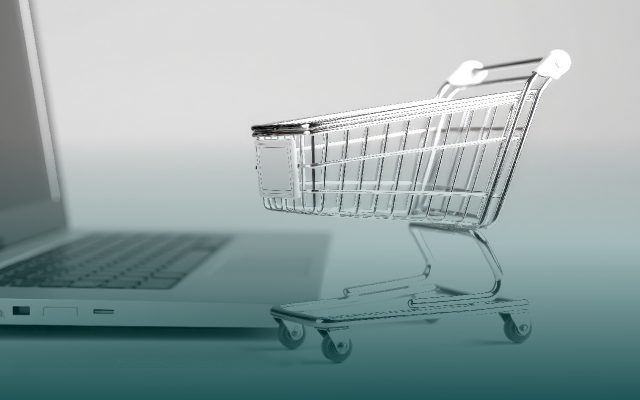With the pace of digital transformation, consumers’ demands have been shifting rapidly. The eCommerce industry is gaining momentum and is saturated with an increasing number of tech-driven options. Retail businesses need to create new interactions with consumers on the level they can feel convenience and accessibility surpassing that of traditional online stores. To deliver greater online experiences to consumers, businesses tend to reevaluate their current strategies and today’s product positioning on the market.
eCommerce is an integral part of the retail business where brands are looking for a way to close the gap and deliver a more authentic and personalized experience to their users, just like they are in-store. That’s how the new era has started, powered by artificial intelligence, virtual and augmented reality, live stream shopping platforms, 3D modeling, and other tangent technologies. According to forecasts by Goldman Sachs, the augmented reality and virtual reality market is anticipated to grow to $95 billion by 2025.
Therefore, to keep pace with customers’ expectations and to stay competitive, business owners need to evolve virtual selling. In this article, we are going to unleash the benefits, use cases, and innovative examples of virtual stores in the retail industry.
What Is a Virtual Store and Why Do You Need One?
A virtual store is the eCommerce environment transformed from the traditional online approaches toward the adoption of connected technologies to bridge the gap between in-store and digital experiences. Virtual shopping is fueled by virtual reality and augmented reality technologies. Whether it is a virtual reality in shopping or a mobile augmented reality application, you get a personalized and interactive experience while selecting furniture items for your kitchen or an exquisite dress for your dancing party. Amid the COVID-19 crisis, the shift to digital shopping has been accelerated by the adoption of VR/AR capabilities enabling consumers to connect in real-time, get immediate detailed answers on their smartphones, virtually try on various products, and get other related recommendations during the buying journey.
For instance, Kendra Scott’s stores affected by the coronavirus crisis kicked off the initiative for their customers to virtually try on various styles of earrings remotely by integrating AR which facilitates the customers’ buying decisions. The post-Covid world has changed. There are examples representing how beauty brands tapped into the virtual environment to comply with pandemic restrictions and increase their profits. Likewise, Ulta incorporated GlamLab virtual tool in their business strategy and boosted the customers’ engagement seven-fold.
Value of Virtual Shopping: Statistics, Proofs, Benefits
With the retail industry disrupted by the coronavirus pandemic, the pursuit of convenient shopping experiences impacted retailers to unveil new opportunities on the market. Considering the preferences and needs of current solvent tech-savvy generations, Millennials and Gen Z, companies have to cater to them and ensure immediacy and real-time interactivity. According to one survey, 70% of online shoppers who have visited virtual stores made at least one purchase. A connected virtual world of the metaverse for Millenials and Gen Z is a bridge to their sophisticated perceptions and demands which means brands have to leave the doors wide open to the connected world. According to McKinsey, the metaverse market is anticipated to generate up to $5 trillion by 2030.
Let’s take a look at how VR shopping can bring value to your retail business.
- Increase in conversion rate
According to Shopify, compared to products without augmented reality, the implementation of AR/3D modeling into the product makes the conversion rate of product interactions 94 percent higher. As Shopify’s statistics show, the conversion rate of product pages has increased by up to 250%. Applying 3D models is more cost-efficient than opposed to traditional photos. For example, Rebecca Minkoff, a designer clothing and accessories brand, empowered their customers’ interactions with 3D modeling, which resulted in 65% more likeliness of buying a product.
- Conversion of online customers to in-store consumers
Due to the lockdown impact, businesses experienced significant losses. Virtual stores are beneficial for retailers who seek new opportunities to reinvent their strategies to achieve instant customer flow to their online and in-store commerce. Being a catalyst for conversions, virtual shopping is capable of saving the future of physical stores by converting online users to in-store foot traffic.
- Elimination of returns
The widespread headache of retailers is the number of returns that could reach a trillion dollars per year. While in-store purchases are returned 5-10%, online purchases returns reach 40 percent. To overcome this issue, VR in retail can assist customers in making more informed decisions following the virtual assessment of the product. Nike was one of the pioneers coming up with the AR initiative, Nike Fit, to struggle with high shipping and return costs. As a result, the mobile app helps customers choose accurate sizing by virtually measuring a foot.
- Customer engagement improvement
According to a NielsenIQ study, 51% of consumers prefer to assess their products before purchasing by using AR. Having the possibility to flexibly visualize the product before the purchase, customers get more insights and the certainty of the product correspondingly. Moreover, in the modern realms, being involved in the immersive world, customers are collaborating with remote friends and exploring new feelings in the virtual world.
- Sales increase
Providing the customer with confidence in the product and ensuring a novel approach toward their engagement, virtually powered apps can drive increased sales and ROI. The previous benefit of reducing returns impacts the bottom line of business performance since a returning customer is a happy one. Building loyalty is one of the prioritized aims of any business, particularly being propelled by digital initiatives. Once you cram your customers with tailored solutions they engage with in real-time at their convenience, the likelihood of sales increases. Additionally, by applying personalized virtual consultancy, your marketing strategy can be enhanced with cross-selling and up-selling opportunities.
- Personalized experiences
Virtual stores enable retailers to analyze clients’ shopping behavior patterns and by streamlining marketing research, deliver remarkable personalized experiences. Plunging into the digital realm, users are focused on their persona: expression. This mainly relates to the fashion industry where customers’ needs are customized in a way they would not be able to repeat in-store. Virtual experience cannot be duplicated when walking into Gucci’s physical mall center and waiting for feedback from the sales representative. Virtual shopping accelerates intentions to buy the product by saturating the whole customer’s self-estimation and self-expression in the virtual world.
Metaverse — A Next Wave of Digital Disruption
What is metaverse? There is no precise definition. Often, internet users associate metaverse with digital virtual games and platforms such as Roblox, Decentraland, Minecraft, etc. We can define “metaverse” as an interactive real-time virtual environment where users can live, work, play, and consume products. It is not only about gaming (yes, its industry is at the forefront of the metaverse) – there are vast avenues to providing business-oriented outcomes. While many executives are still skeptical of their visions about metaverse advancements, it doesn’t mean that the transition from eCommerce to the virtual world is not gaining momentum.
Indeed. Being an innovative hyper-interactive digital environment, the metaverse is on its fancy stage. However, the opportunities it opens up for luxury and beauty brands and retailers are enormous. Especially, since it represents a huge potential for tech-savvy customers with new demands. To uncover new value streams, retail businesses have to understand what the digital world looks like how it is functioning, and how to apply a fresh approach toward new levels of creativity and interactive commerce. Since in-app social eCommerce prevails in modern realms of consumers, the digital metaverse and VR in shopping can be a catalyst for the appearance of new revenue streams.
Nevertheless, the metaverse is still in its foundation path. According to the McKinsey survey of 3,400 consumers, 79% of respondents made a purchase. The executives’ estimations are also positive: 95% of them believe metaverse will positively shift their business. In another survey conducted by McKinsey, which queried over 1,000 consumers aged 13-70, the most popular interest in the metaverse digital activity belongs to shopping.

The main barriers to the wide adoption of VR retail are the low penetration of immersive devices among consumers and technical challenges.
To proceed with deep diving into the use cases of virtual environments, it is worth noting about NFT – nonfungible tokens. They confirm the sole ownership of the designated owner of the digital product that exists on the blockchain. They can be defined as digital certificates of authenticity which are useful in purposes to securely track the owners of digital assets. NFTs are 100% unique. Let’s take some examples of how well-known retail brands are ramping up initiatives in the virtual marketplace via applying metaverse and NFTs.
Having acquired the virtual sneaker brand RTFKT Studio, Nike tapped into the metaverse with its Nikeland initiative to sell virtual sneakers. By the way, RTFKT Studio managed to sell out 600 pairs of sneakers raising $3,1 million in seven minutes.
Virtual Store Use Cases
1. Virtual Try-on
Since Millennials and Gen Z spend a lot of time in spaces where they can get interactive and personalized experiences, brands and retailers must penetrate the virtual world to engage customers and drive sales. Backed by 3D body scanning technology, AR has the potential to reinvent the retail experience in the fashion, cosmetics, and luxury industries. How does it work? With a camera-equipped gadget and 3d virtual fitting technology, a customer can get a real-world image of how an outfit will look on their bodies. With virtual try-on technology, customers can try on garments, cosmetics, and luxury items for fit, size, and look without the need to do it physically. Gucci, for instance, offers their customers to try on sneakers via the app.

There is also the alternative to create your own avatar of yourself and then put on virtual clothing in the way you want. 3D LOOK’S Your Fit solution is geared at providing buyers with the ability to represent the measurements of the person offering accurate size recommendations and interactive shopping journeys tailored to unique body shapes.
Collaborating with Google Search, Burberry launched an AR-powered initiative for their customers, giving them the possibility to get an accurate sense of the product as it is in the real world.
L’Oréal was the first company that partnered with Snap Camera to engage customers with its branded content. The brand incorporated AR technology in the form of AR lenses on Snap’s desktop app, allowing customers to try on different looks from Garnier, Lancôme, L’Oréal Paris, and Maybelline. Similarly, Kohl stepped in partnership with Snapchat to implement Kohl’s AR Virtual Closet to help customers browse virtual selections of gear and create trendy outfits from the comfort of their homes. We can name more brands that unveiled tech-progressive solutions: Sephora, Kendra Scott, IKEA, Home Depot, Louis Vuitton, Levi’s, etc.
2. 3D Webstores
The possibility to virtually browse stores allows retailers to converge the experience customers get in brick-and-mortar stores and eCommerce features. That means you appear on the unconventional website equipped with virtual-powered capabilities, including interactive access to the physical stores through 3D rendering. Such visual elements as 3D models, 360-degree view, and technology that is similar to Google Street View provide shoppers with an immersive experience of walking around the store. For instance, Ralph Lauren’s 3D webstore enables users to virtually move around the store by clicking on the arrows and appropriate icons, which represent detailed product information leading to the cart. Likewise, such giant fashion brands as Tommy Hilfiger, Burberry, and Gucci also tapped into this path.

With virtual reality shopping, customers get a doubled experience of gratification since virtual exploring of the store allows them to save time and hassle as well as digitally transform to in-real-life shopping, as in the example of Christian Dior offering the chance to visit its Champs-Elysées boutique.

3. Gamification — Digital Entertainment Approach
As we mentioned before, gaming is not the only use case for applying digital products. However, it is a great way to be integrated into virtual reality in retail and form a holistic strategy of customer engagement. One of the notorious examples is Nike, which in collaboration with Roblox rolled out Nikeland to deliver a new-level shopping experience to its consumers. In the Nikeland Showroom, users can deck out their avatars from a collection of shoes and clothes and play sports in the virtual game.
For its bicentennial, the Louis Vuitton brand launched a video game with collectible NFT postcards, which gained 200 million downloads.
Final Thoughts
Digitalization is gaining momentum in the retail industry, offering such solutions as virtual reality stores, AR, and gamified experiences in the metaverse. Though customers (according to research) are excited about how brands are stepping into a digital experience, the total adoption of VR for retail is terminated due to technical challenges and a lack of talent to meet the demand for growth. There are a lot of myths indicating that VR ecommerce is a fad. Modern marketplaces have been changing with the shifting demands of the customers whose lifestyle dictates how to consume content and how to engage with products. Therefore, businesses must adapt to new realms and keep a pulse on technological advancements, which open up new avenues for customer engagement and building loyalty.
Immersive content backed by virtual realities strengthens customer relationships, drives sales, helps build a powerful community base, and ensures sales revenue increase via an omnichannel approach. Moreover, with VR in e-commerce, you can conduct various research marketing activities. So that retailers can easily try out different ways of store design, item location, and product layout to boost conversion in real life.
Based on the aforementioned use cases, we understand that both consumers and retailers are likely to embrace virtual store technologies, even if they are immature for the present. Now that you know how augmented and virtual realities are changing eCommerce and the way people shop, we invite you to talk with our specialists about your eCommerce website development accelerated with virtual technologies.

Our Engineers
Can Help
Are you ready to discover all benefits of running a business in the digital era?

Our Engineers
Can Help
Are you ready to discover all benefits of running a business in the digital era?







